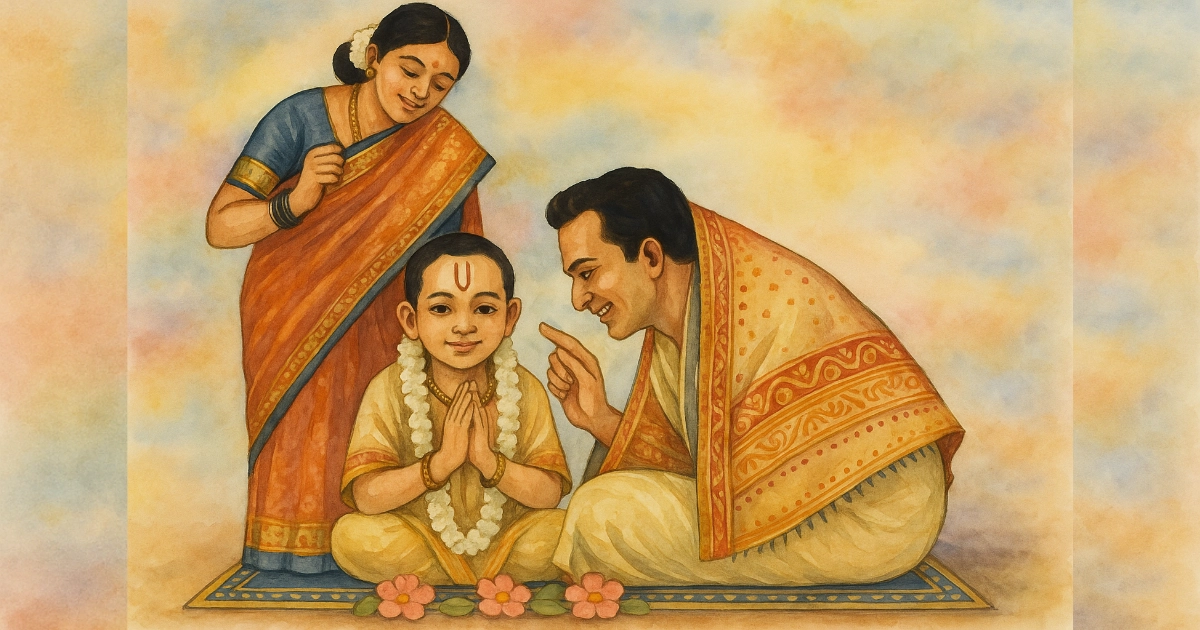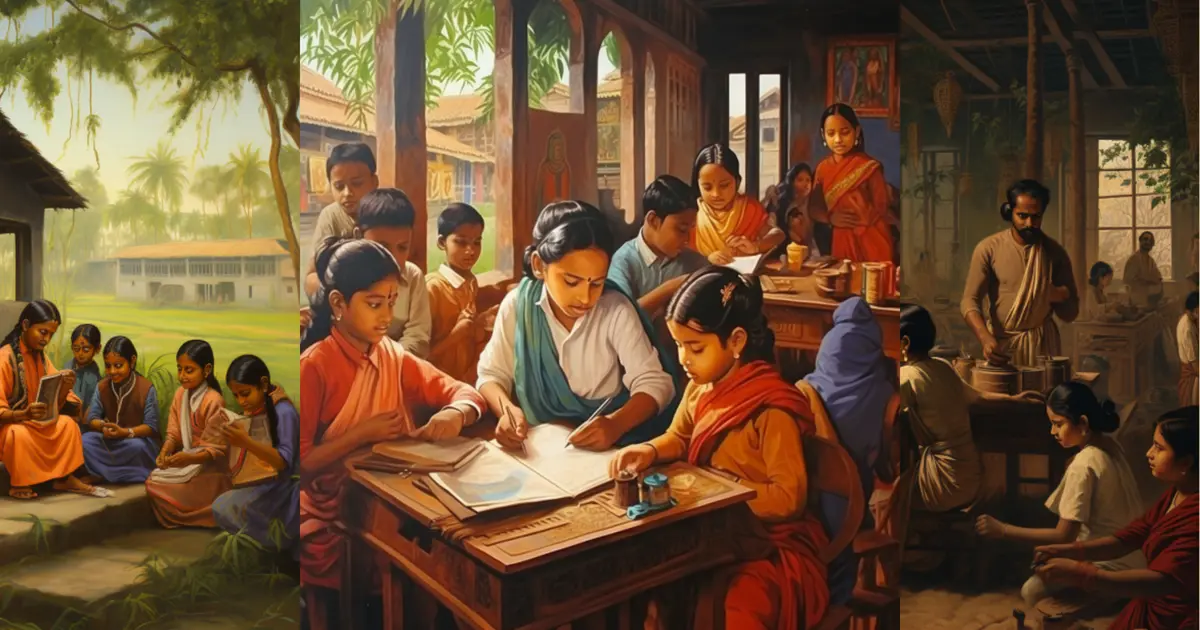This essay is Part 3 in a series. The previous installments can be accessed here:
The various rituals of the upanayana sacrament and the mantras recited during the process provide significant insights beneficial to education. Let us now examine these.
Rituals and Mantras
At the start of the upanayana, there is a practice called mātṛ-bhojana (mother's meal), which is also mentioned in the Mānava Gṛhya Sūtra. Following this meal, the child undergoes vapaṇa (shaving) and then snāna (bathing). This sequence of events — meal, shaving, and then bathing—is unusual in Hindu rituals but serves a particular purpose in upanayana.
Before the child adopts the strict disciplines of brahmacarya, he is given one last opportunity to dine in the company of his mother. This symbolic act represents the conclusion of his carefree childhood. After this, the child undergoes a shave, an act often associated with purification in Hindu sacraments.
Post-bathing, the child is tied with a mekhalā (girdle) around his waist and given a kaupīna (loincloth). The initiation of wearing a loincloth marks the end of childhood in the child’s mind and the beginning of disciplined brahmacarya. By the twelfth year, a brahmacārī would replace the loincloth with a dhoti, symbolizing a stage-appropriate transition (as mentioned in Vīramitrodaya, p.432).
The mekhalā was made of three strands, symbolizing dedication to the study of the three Vedas. This practice, described in Āśvalāyana’s words quoted in Vīramitrodaya (p.462), reminded the brahmacārī of his responsibility to immerse himself in the Vedas:
Veda-trayeṇāvṛto 'ham iti manyeta sa dvijaḥ
The twice-born should consider himself enveloped by the three Vedas.
The mantra recited while donning the mekhalā appears in almost all Gṛhya Sūtras:
Ṛtasya goptṛ tapasas tarutṛ ghnatī rakṣāṁsi saha-mānā arātīḥ।
Sā māṁ samantam abhihyehi bhanye vartāras te subhage mā riṣām॥
This mantra instills the belief that the mekhalā, worn day and night, would safeguard the wearer’s purity and enhance his moral and physical strength.
Since sitting bare-bodied during religious acts is considered improper in Hindu society, the brahmacārī is also given an upariṇa (upper garment) during the upanayana.
In ancient times, when the art of weaving was unknown, the upariṇa (upper garment) was made from deer skin. Therefore, during the upanayana ceremony, a ritual involving the use of ajina (deer skin) is often mentioned. According to the Gopatha Brāhmaṇa, the bright and lustrous deer skin symbolizes brahmavarchas (spiritual radiance), which the brahmacārī is encouraged to aspire to while wearing it. This demonstrates how the scriptures ensured that the duties of the brahmacārī were always at the forefront of his mind.
After the development of weaving, the need for deer skin diminished. Consequently, the Taittirīya Āraṇyaka provided an option: one could either use a woven cloth or deer skin as the upper garment:
Ajinaṁ vāso vā dakṣiṇata upavīya
Taittirīya Āraṇyaka 2.1
However, the Hindu tradition’s inclination to preserve ancient practices led to the continued use of both deer skin and woven cloth during the upanayana ceremony.
According to the Baudhāyana and Mānava Gṛhya Sūtras, the upariṇa given to the initiate during upanayana should be freshly made, preferably woven at home (sadyaḥ kṛttotam). This indicates that in ancient times, spinning thread and weaving cloth were common household activities.
Yajñopavīta
Interestingly, detailed descriptions of upanayana in various Gṛhya Sūtras do not mention the use of yajñopavīta (sacred thread) as a mandatory element. This omission might seem surprising to contemporary Hindu society, but those familiar with the origins of the yajñopavīta will find it logical. In the early days, the ajina (deer skin) or upariṇa (upper garment) served the same purpose as the yajñopavīta.
The term yajñopavīta originates from the cloth draped over the left shoulder and under the right arm during Vaidika rituals. This tradition is reflected in the Taittirīya Saṁhitā, which states:
Vāsovināyasa-viśeṣo yajñopavītam। Dakṣiṇaṁ bāhum uddharate avadhatte saṁyam iti yajñopavītam iti brāhmaṇam ||
The specific arrangement of cloth over the left shoulder and under the right arm is referred to as yajñopavīta.
This shows that the yajñopavīta was originally the ritual use of the upariṇa, which later evolved into the modern sacred thread.
The use of cloth for yajñopavīta (sacred thread) like the upariṇa (upper garment) was considered ideal. Only when cloth was unavailable, a thread was to be used. This was the view of Ṛṣyaśṛṅga Ṛṣi. Over time, the idea that one's entire life is a continuous yajña (sacrifice) became established. However, it became impractical to wear an upariṇa as a yajñopavīta at all times of the day. Consequently, Smṛtikāras introduced the simplified use of the thread as the yajñopavīta, leading to the adoption of the modern janeū.
The Āpastamba Dharma Sūtra confirms this:
Nityam uttaram vāsaḥ kāryam। Api vā sūtram evopavītārthe।
A cloth should always be worn as an upper garment, or alternatively, a thread may be used as a yajñopavīta.
This highlights how secondary the janeū was in the original upanayana rituals.
Once the mekhalā (girdle), kaupīna (loincloth), and yajñopavīta were donned, the main part of the upanayana began. The child was then introduced to the fire sacrifice, a central element of Aryan religious practices. The boy would offer sacred twigs (samidh) into the fire, symbolizing a prayer to Agni, the ancient and revered Vaidika deity, to bless him with radiance and strength. For example, the Bhāradvāja Gṛhya Sūtra (1.5) includes a mantra invoking Agni to make the initiate as radiant and strong as fire itself.
To impress upon the child the dual importance of brahmacarya (celibacy) for both education and moral conduct, the student was symbolically entrusted to the care of Vaidika deities like Bhaga, Yama, Arthman, and Savitar.
Deva Savitar eṣa te brahmacārī samā mṛta |
O God Savitar, this Brahmacārī is offered to you for protection.
This mantra was recited, signifying that divine forces would support the student as long as they upheld the vow of brahmacarya. These prayers instilled in the student a deep sense of self-confidence and the belief that God would always protect them during their pursuit of education.
The guru would then ask the student, Whose Brahmacārī are you? The student would naturally respond, I am your student. The guru would correct him, saying, You are not my Brahmacārī but that of the mighty and radiant gods, like Indra and Agni. I am merely their representative, teaching you at their command.
This conveyed the sacredness of education and the preservation of culture, emphasizing that divine powers actively supported deserving students. It reinforced the belief that acquiring knowledge and safeguarding tradition were divine duties. Establishing unwavering trust and affection between the guru and the student was seen as essential for effective education. To strengthen this bond, the ritual of hṛdaya-sparśana (touching the heart) was performed, symbolizing the emotional connection required for the student’s rapid progress.
During the upanayana ceremony, the guru would place his hand on the student’s chest and chant a mantra expressing the wish for enduring mutual love and trust between them (Hi. G. Sū. 2.5.11). Along with love and trust, determination is essential for acquiring knowledge. To emphasize this, the ritual of aśma-ārohaṇa (stone climbing) was performed. The guru would make the student stand on a stone while chanting a mantra that urged him to be as firm and resolute as the stone itself (Mā. Gṛ. Sū. 1.22.12).
After this, the formal upanayana rite was considered complete, and the guru began teaching the student the Vedas. The sun, a symbol of purity and brilliance, was among the most revered deities since ancient times. Hence, the student’s first lesson involved learning a prayer to Savitṛ (the sun). This prayer, known as the Sāvitrī mantra, was later called the Gāyatrī mantra because it was composed in the Gāyatrī meter for Brahmins:
Tatsavitur vareṇyaṁ bhargo devasya dhīmahi।
Dhiyo yo naḥ pracodayāt॥
Ṛgveda 3.62.10Let us meditate on the supreme radiance of the deity Savitṛ,
so that he may inspire our intellect.
The student was also given a daṇḍa (staff) for confidence during travel at night or while bathing in unfamiliar waters. The daṇḍa had an additional purpose: it symbolized that the student was a traveler on the path of knowledge. Carrying the daṇḍa instilled in the student a sense of their identity as a pilgrim aspiring to reach the land of wisdom.
After receiving the daṇḍa, the student would go out for bhikṣā-caraṇa (begging for alms). The first day’s alms-seeking was largely symbolic, involving relatives like the mother or aunt. However, throughout brahmacarya, the student was expected to live on alms, as recommended by dharmaśāstras. How closely this was followed in practice will be discussed in the third chapter.
On the third day after upanayana, a special ritual called medhā-janana (intelligence generation) was performed to enhance the student’s intellect and efficiency. With this, the upanayana rites concluded.
In ancient times, when the meanings of the rituals and mantras were well understood, society derived immense benefit from the upanayana ceremony. It was a turning point, symbolizing the beginning of a disciplined life characterized by self-reliance, self-respect, and self-control. The messages instilled through the mantras emphasized that knowledge is challenging to acquire but achievable through determination and focus. The mantras conveyed that divine assistance was granted through upanayana, empowering the student to be as strong as Indra and as radiant as Agni.
The student was taught that nothing would be impossible if they adhered to the ashram’s rules and that even death could be overcome through steadfast discipline. This sense of confidence and optimism, inspired by the upanayana mantras, had profound psychological and educational benefits. It reinforced the idea that a resolute and disciplined life would lead to success, as both divine support and inner strength were assured.
We will revisit the remaining rituals at a later time and shift our focus to the topic of education during the Ṛgvedic era.
In Ṛgveda, The focus of learning in Vaidika schools was the hymns, and the first step in this process was to teach these sacred texts to students through recitation. The atmosphere was filled with the rhythmic chanting of the hymns, a characteristic scene in Vaidika schools. This pervasive practice even inspired a hymn in the Ṛgveda (vii.103), which poetically likens the repetitive recitation by teachers and their students to the croaking of frogs rejoicing at the arrival of rain. The teacher (śikṣaka) speaks, and the students (śiṣya) repeat after him (anuvadati), creating a rhythmic, monotonous cadence similar to the chorus of frogs.The recitation of Vaidika texts was cultivated as a refined art, emphasizing the sacred significance of the sounds of letters and syllables used in chanting. These sacred utterances were not left to natural or personal variations in pronunciation; instead, they were meticulously regulated using meters (chhandas). Ṛgveda (i.164.24) explicitly explains that syllables (akṣaras) combine to form seven meters (sapta chhandāṃsi), which are:
- Gāyatrī – 24 syllables
- Pankti – 28 syllables
- Anuṣṭubh – 32 syllables
- Bṛhatī – 36 syllables
- Virāj – 40 syllables
- Triṣṭubh – 44 syllables
- Jagatī – 48 syllables
The verse further describes how a meter (chhandas) is composed of pādas (divisions), and these pādas consist of akṣaras (syllables). As Sāyana explains, akṣaras are the foundational unit for structuring the Ṛgveda into varga (sections), sūkta (hymns), and anuvāka (subsections).
The Ṛgveda was recited in three main ways:
- Pada Pāṭha – Breaking down words into individual components.
- Krama Pāṭha – Reciting words in pairs.
- Saṃhitā Pāṭha – Continuous recitation without breaks.
There was also a well-developed phonological system. The Aitareya and Śatapatha Brāhmaṇas classified sounds into categories such as:
- Ghoṣa (voiced sounds)
- Uṣman (aspirates)
- Vyañjana (consonants) \ They also distinguished sounds like dental and lingual n, and the three sibilants: ṣ, ś, and s, along with rules of sandhi (word combinations).
The Taittirīya Upaniṣad (i.x.2) recognized additional phonological elements such as:
- Mātrā – Quantity of sound.
- Bala – Accent or emphasis.
- Sama – Euphony or harmony of sounds.
- Santāna – Sequential relationship of letters.
Students began their recitation of Vaidika texts before dawn, as noted in the Taittirīya Saṁhitā (vi.4.3.1), which mentions reciting before birds began chirping (pūrva-vāyabhyah). The Aitareya Āraṇyaka (viii) also records three methods of recitation, reinforcing the structured and disciplined approach to Vaidika education.
References
- Vīramitrodaya
- Gṛhya Sūtra
- Gopatha Brāhmaṇas
- Taittirīya Āraṇyaka & Saṃhita
- Baudhāyana Sūtra
- Mānava Gṛhya Sūtra
- Āpastamba Dharma Sūtra
- Bhāradvāja Gṛhya Sūtra
- Aittareya Āraṇyaka & Brāhmaṇa
- Śatapatha Brāhmaṇa
- Ṛgveda Hindi: Free Download, Borrow, and Streaming: Internet Archive. (2015). Internet Archive.
- Atharvaveda hindi e book: Free Download, Borrow, and Streaming: Internet Archive. (2020, April 26). Internet Archive





